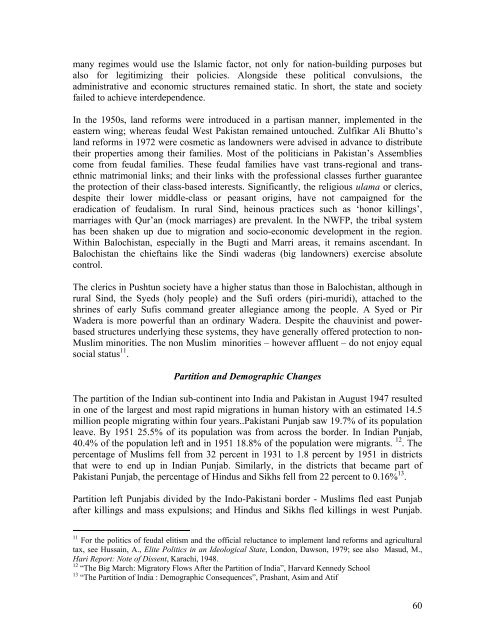Living on the Margins. Minorities in South Asia - EURAC
Living on the Margins. Minorities in South Asia - EURAC
Living on the Margins. Minorities in South Asia - EURAC
- TAGS
- minorities
- eurac
- www.eurac.edu
Create successful ePaper yourself
Turn your PDF publications into a flip-book with our unique Google optimized e-Paper software.
many regimes would use <strong>the</strong> Islamic factor, not <strong>on</strong>ly for nati<strong>on</strong>-build<strong>in</strong>g purposes but<br />
also for legitimiz<strong>in</strong>g <strong>the</strong>ir policies. Al<strong>on</strong>gside <strong>the</strong>se political c<strong>on</strong>vulsi<strong>on</strong>s, <strong>the</strong><br />
adm<strong>in</strong>istrative and ec<strong>on</strong>omic structures rema<strong>in</strong>ed static. In short, <strong>the</strong> state and society<br />
failed to achieve <strong>in</strong>terdependence.<br />
In <strong>the</strong> 1950s, land reforms were <strong>in</strong>troduced <strong>in</strong> a partisan manner, implemented <strong>in</strong> <strong>the</strong><br />
eastern w<strong>in</strong>g; whereas feudal West Pakistan rema<strong>in</strong>ed untouched. Zulfikar Ali Bhutto’s<br />
land reforms <strong>in</strong> 1972 were cosmetic as landowners were advised <strong>in</strong> advance to distribute<br />
<strong>the</strong>ir properties am<strong>on</strong>g <strong>the</strong>ir families. Most of <strong>the</strong> politicians <strong>in</strong> Pakistan’s Assemblies<br />
come from feudal families. These feudal families have vast trans-regi<strong>on</strong>al and transethnic<br />
matrim<strong>on</strong>ial l<strong>in</strong>ks; and <strong>the</strong>ir l<strong>in</strong>ks with <strong>the</strong> professi<strong>on</strong>al classes fur<strong>the</strong>r guarantee<br />
<strong>the</strong> protecti<strong>on</strong> of <strong>the</strong>ir class-based <strong>in</strong>terests. Significantly, <strong>the</strong> religious ulama or clerics,<br />
despite <strong>the</strong>ir lower middle-class or peasant orig<strong>in</strong>s, have not campaigned for <strong>the</strong><br />
eradicati<strong>on</strong> of feudalism. In rural S<strong>in</strong>d, he<strong>in</strong>ous practices such as ‘h<strong>on</strong>or kill<strong>in</strong>gs’,<br />
marriages with Qur’an (mock marriages) are prevalent. In <strong>the</strong> NWFP, <strong>the</strong> tribal system<br />
has been shaken up due to migrati<strong>on</strong> and socio-ec<strong>on</strong>omic development <strong>in</strong> <strong>the</strong> regi<strong>on</strong>.<br />
With<strong>in</strong> Balochistan, especially <strong>in</strong> <strong>the</strong> Bugti and Marri areas, it rema<strong>in</strong>s ascendant. In<br />
Balochistan <strong>the</strong> chiefta<strong>in</strong>s like <strong>the</strong> S<strong>in</strong>di waderas (big landowners) exercise absolute<br />
c<strong>on</strong>trol.<br />
The clerics <strong>in</strong> Pushtun society have a higher status than those <strong>in</strong> Balochistan, although <strong>in</strong><br />
rural S<strong>in</strong>d, <strong>the</strong> Syeds (holy people) and <strong>the</strong> Sufi orders (piri-muridi), attached to <strong>the</strong><br />
shr<strong>in</strong>es of early Sufis command greater allegiance am<strong>on</strong>g <strong>the</strong> people. A Syed or Pir<br />
Wadera is more powerful than an ord<strong>in</strong>ary Wadera. Despite <strong>the</strong> chauv<strong>in</strong>ist and powerbased<br />
structures underly<strong>in</strong>g <strong>the</strong>se systems, <strong>the</strong>y have generally offered protecti<strong>on</strong> to n<strong>on</strong>-<br />
Muslim m<strong>in</strong>orities. The n<strong>on</strong> Muslim m<strong>in</strong>orities – however affluent – do not enjoy equal<br />
social status 11 .<br />
Partiti<strong>on</strong> and Demographic Changes<br />
The partiti<strong>on</strong> of <strong>the</strong> Indian sub-c<strong>on</strong>t<strong>in</strong>ent <strong>in</strong>to India and Pakistan <strong>in</strong> August 1947 resulted<br />
<strong>in</strong> <strong>on</strong>e of <strong>the</strong> largest and most rapid migrati<strong>on</strong>s <strong>in</strong> human history with an estimated 14.5<br />
milli<strong>on</strong> people migrat<strong>in</strong>g with<strong>in</strong> four years..Pakistani Punjab saw 19.7% of its populati<strong>on</strong><br />
leave. By 1951 25.5% of its populati<strong>on</strong> was from across <strong>the</strong> border. In Indian Punjab,<br />
40.4% of <strong>the</strong> populati<strong>on</strong> left and <strong>in</strong> 1951 18.8% of <strong>the</strong> populati<strong>on</strong> were migrants. 12 . The<br />
percentage of Muslims fell from 32 percent <strong>in</strong> 1931 to 1.8 percent by 1951 <strong>in</strong> districts<br />
that were to end up <strong>in</strong> Indian Punjab. Similarly, <strong>in</strong> <strong>the</strong> districts that became part of<br />
Pakistani Punjab, <strong>the</strong> percentage of H<strong>in</strong>dus and Sikhs fell from 22 percent to 0.16% 13 .<br />
Partiti<strong>on</strong> left Punjabis divided by <strong>the</strong> Indo-Pakistani border - Muslims fled east Punjab<br />
after kill<strong>in</strong>gs and mass expulsi<strong>on</strong>s; and H<strong>in</strong>dus and Sikhs fled kill<strong>in</strong>gs <strong>in</strong> west Punjab.<br />
11 For <strong>the</strong> politics of feudal elitism and <strong>the</strong> official reluctance to implement land reforms and agricultural<br />
tax, see Hussa<strong>in</strong>, A., Elite Politics <strong>in</strong> an Ideological State, L<strong>on</strong>d<strong>on</strong>, Daws<strong>on</strong>, 1979; see also Masud, M.,<br />
Hari Report: Note of Dissent, Karachi, 1948.<br />
12 “The Big March: Migratory Flows After <strong>the</strong> Partiti<strong>on</strong> of India”, Harvard Kennedy School<br />
13 “The Partiti<strong>on</strong> of India : Demographic C<strong>on</strong>sequences”, Prashant, Asim and Atif<br />
60

















